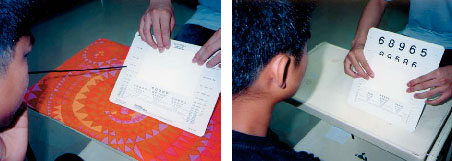 
|
Near vision tests: LEA SYMBOLS® line test with 100% spacing and on the reverse size with 50% and 25% spacing. |
Near vision acuity, line test with the LEA SYMBOLS® and the LEA NUMBERS®
1. Use either a near vision card, the LEA-Screener or - in cases of severe low vision - the lower part of a distance vision chart. Discuss the names of the symbols or agree on pointing/signing as the mode of answering. Measure visual acuity at 40cm binocularly and then monocularly. It is important to assess visual acuity also at the distance that the child prefers to use when looking at pictures and texts. Ask the child to hold the test at the distance and angle that he/she feels comfortable and measure visual acuity at that distance. If the child needs near correction and it is available, use it during the measurement.

Test situations using the line test with the LEA SYMBOLS® and the LEA NUMBERS®
2. Write down the results as the M-value (M-value is the physical, printed size of the optotype. A 3.2M optotype corresponds to visual acuity 1.0 (6/6, 20/20) at a distance of 3.2m, a 9.5M optotype at a distance of 9.5 meters.) and the distance used and calculate the VA-value by dividing the distance used (in meters) by the M-value, i.e. if the child read 3.2M at 30cm (30cm= 0.3m), then 0.3/3.2 = 3/32 = 6/60. If the decimal notation is used, the calculation is following: 0.3/3.2 = 3/32 = 0.1. If the American 20/20 notation is used, it is 0.3/3.2 = 3/32 = 1/10 = 20/200. If you find the calculation too difficult, report the M-value and the distance used to the ophthalmologist or optometrist. If you use the 40cm near vision card at the standard distance, you can read the visual acuity value next to the line read by the child.
3. If the binocular visual acuity is less than the acuity of the better eye, explore with the child whether the eye with the worse VA should be covered to enhance vision during demanding near vision tasks or whether the cover disturbs vision. Sometimes blurring can be caused by a small angle squint which could be corrected with glasses, and which should be reported to the child's low vision optometrist or ophthalmologist (where available).
In some cases you will find that visual acuity at the preferred distance is lower than it is at the standard 40cm distance. This means that the child prefers a larger but blurred image. If possible, ask the optometrist to find out whether the image can be made clearer with appropriate reading lenses for this distance.
Previous Chapter 
|
 Next Chapter Next Chapter
|